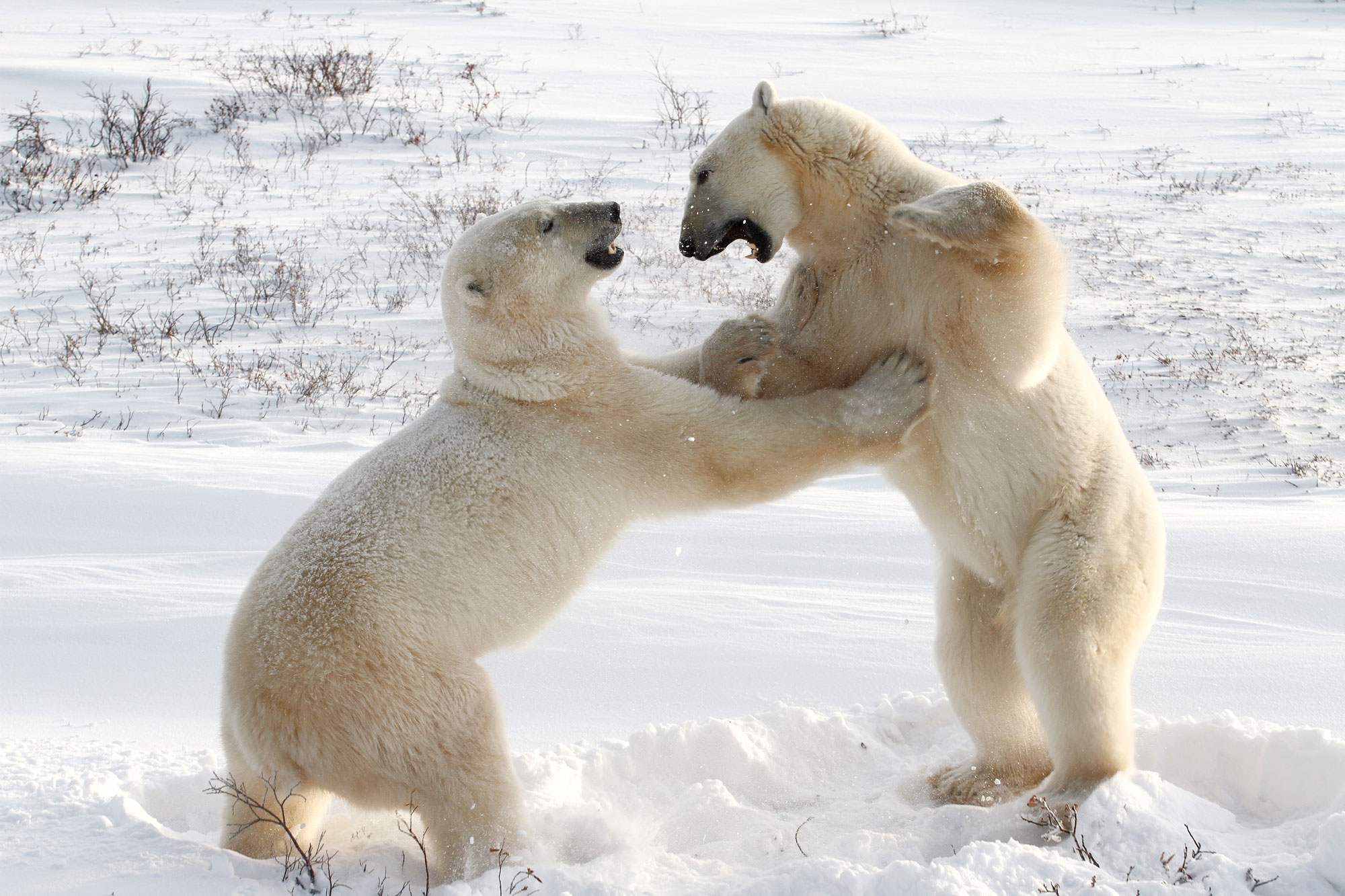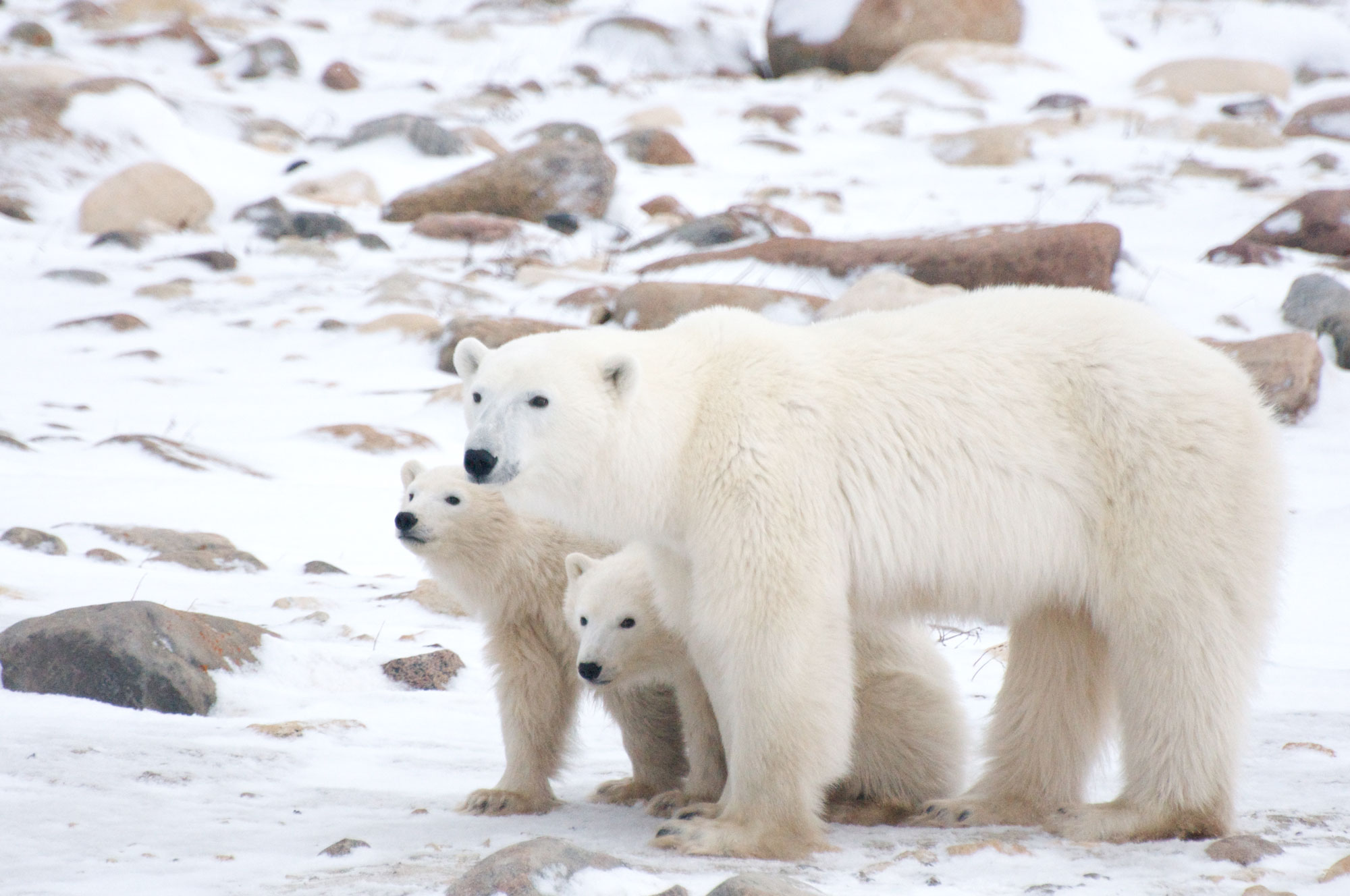On the Manitoba tundra, a polar bear awakens from an early afternoon snooze in a patch of willows, stands, and begins to amble toward me.
Were I not sitting inside a Tundra Buggy—a custom all-terrain vehicle designed to navigate subarctic terrain, and protect tourists from these carnivores—I’d be terrified. But inside the Buggy, which is elevated on five-foot tall wheels, I’m safe to observe the 1,000-pound bear in its natural habitat, take photos, and chat about its behavior with my fellow passengers—much like the wildlife safaris of Africa.
What’s different from your standard wildlife safari is that I’m sitting beside one of the foremost polar bear researchers on the planet, Steven C. Amstrup, PhD, the chief scientist at Polar Bears International. The Conservation Journey is a first-of-its-kind offering from Canadian outfitter Frontiers North Adventures, where ordinary tourists spend four days in the field with wildlife biologists and scientists like Amstrup, viewing polar bears and learning about conservation efforts. If a wildlife safari and ecotourism had a lovechild, this trip would be it.
By day, we follow old military paths worn into the tundra, tracking the normally elusive Ursus maritimus at the time of year when their movement is most predictable—early November. At this time, the bears gather along the shores of Hudson Bay, eagerly awaiting the winter sea ice formation so they can hunt seals after a long summer fast. At nightfall, back at the Tundra Buggy Lodge, tourists and scientists mingle over drinks, dine together, and watch world-renowned polar bear experts present slideshows.

During one such presentation, I learn the Hudson Bay polar bear population is down 22 percent since the early 1980s. The culprit? Greenhouse gas emissions, which are causing the Arctic to warm and the ice on Hudson Bay to form later (and melt sooner). This is shrinking the window when the polar bears can hunt seals—their main food source—out on the ice.
It’s an intense experience to absorb, both the exhilaration of seeing the bears in their native habitat—moms and cubs, curious young adults approaching the Tundra Buggy, males sparring—and the agitation in learning the details of their impending demise. Amstrup predicts that unless we take action to stop climate change, we will lose two-thirds of all polar bears by the middle of the century and the rest by the end of the century.
The strong emotions I experience during my visit are exactly what conservation organizations like Polar Bears International seek to create. “Coming up here and seeing a polar bear, looking into its eyes, it can change people, change how they care about the environment,” says Amstrup. There's even a buzzword for this type of travel that's taking place on the sub-arctic tundra: conservation travel.
Polar bear experts like Amstrup agree that polar bear conservation is complex. We chat about it over hot cider on the Tundra Buggy, while watching two young bears wrestle. “It kind of turns classic wildlife conservation on its head,” he says. “Polar bear conservation can’t be done in the Arctic, it’s not a matter of putting up a fence or designating a preserve; it’s about stopping the rising temperatures that are destroying their habitat. The only way we can do that is to stop the rise in greenhouse gases, and that happens back home.”
It’s a daunting truth, but Amstrup is hopeful.
“We haven’t yet crossed an irreversible tipping point with climate change,” he says.
Nor are we powerless to act. He says that simple things we do around the house can make a difference. “If everyone in America turned down their thermostat by one degree, it would save an amount of energy equal to all the energy used by the state of Iowa in one year.”
I look out the window and watch the bears: their wrestling session has ceased and one lays down to rest in the willows. The other catches a whiff of lunch being served on the Tundra Buggy and walks over to investigate. It sniffs the front tire, then walks over toward my window and stops. Rearing back on its hind legs, the bear plants its frying-pan sized paws on the Buggy just below my window and peers up at us.
Amtrup chuckles at the bear’s curiosity. “What we’re really doing is inspiring people to go home and work more toward a sustainable world,” he says. “We can save polar bears.” Looking down through the window at the polar bear as it stretches up even closer toward me, I realize how badly I want Amstrup to be right.
Written by Jayme Moye for Elevation Outdoors Magazine.
About Frontiers North Adventures
Frontiers North Adventures has been specializing in adventure tours in Canada’s north since 1979, ensuring travelers have the opportunity to view and photograph the wildlife of the North as well as learn about the people of the North, their culture, history and customs. Dedicated to making socially, environmentally, and ethically responsible decisions that contribute to the well being of their employees, guests, local community and the environment, Frontiers North believes that hosting guests in Canada’s north should benefit the communities and ecosystems in which they operate. For more information, please visit www.frontiersnorth.com



